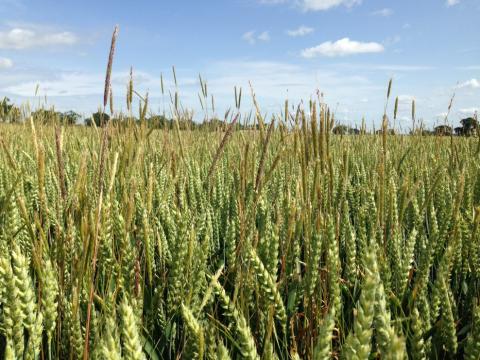Weed control is becoming more challenging...
- Herbicide availability is declining with few new modes of action being developed.
- Herbicide resistance amongst weeds is increasing.
As such it is key that we:
- Improve and implement integrated weed management approaches including optimising cultural weed control
- Maximise herbicide performance when they need to be applied.
- Improve understanding of the complex competitive interactions between weeds and crops and how these can change.
This post investigates how modelling can be used to understand the weed-crop system and how this can aid weed management using a DEFRA project as a case study.
Some examples of how models can be used in weed biology and management:
- Yield loss prediction - based on the infestation levels of weed species in fields and the competitiveness of both the weed species present and crops being grown in that field.
- Threshold levels - at what level of weed infestation does management become economically appropriate?
- To develop the most effective short and long term solutions for weed management - by incorporating environmental factors such as local climate and solar radiation levels these solutions can be made regionally appropriate.
- To determine the optimal spatial (where) and temporal (when) management interventions - for example by targeting weeds at a particular growth stage or time during the growing season when intervention is most likely to be successful.
- To predict and understand the evolution and spread of resistance to herbicide in weeds - by using genetic, management and ecological factors to understand the likelihood of resistance arising and the rate at which is may spread. This is particularly relevant in the UK as we are carefully monitoring the glyphosate resistance risk in weeds.
Case Study: GROWTH AND COMPETITION MODEL FOR ORGANIC WEED CONTROL (DEFRA)
This DEFRA project is an example of the development of a model for weed control. In this case the model was a 'growth and competition' one for use in organic systems, it was developed using data on the growth of crops and weeds as they competed for light and space before and during canopy closure. The model could then be applied to simulate crop and weed growth of multiple cohorts so that the onset of crop weed competition could be predicted. A short summary is provided here and the whole report is linked at the bottom of the page. It highlights some of the main aspects of agricultural model development including model parameterisation, and model validation and fitting by using historical and experimental data.
Background
The major obstacle identified in weed control in organic systems was the lack of reliability of current weed control methods. A significant way forwards in organic farming, and in convincing people to convert to organic farming, was to add more confidence and reduce the uncertainty from the weed management decision making process. Organic farming can use both 'coarse' control methods such as rotations and stale seedbeds as well as 'fine' control methods, which includes mechanical weeding and thermal control. This 'fine' control can be costly in terms of time, machinery and labour but there is always a need for some degree of this for effective weed control. A major aim of this project was thus to target 'fine' control and help reduce input costs and make it less time consuming to implement. Furthermore by improving the targeting of weed management, soil disturbance can be reduced by minimising the number of weed operations required and only applying them at the optimal times.
Aims
- To develop a MATLAB software program encoding a growth and competition model to predict the optimal weeding times of a variety of organically produced vegetable crops (cabbage, carrot and onion)
- To validate the model using historical and new experimental data
- Test the predictions of the model to see if it can be extended to related species
- Inform the organic growers or the results of model simulations so they can implement the findings in their own management.
Developing the model
- Model inputs: solar radiation, crop weights and numbers (adjusted for wider spacing practiced in organic systems), weed weights and numbers during early weeks of crop growth
- Solar radiation was used to drive the model.
- All growth parameters in the model were species specific for the crops (cabbage, carrot and onion were the 3 species first parametrised), and then a general set of parameters representing the mean of a range of parametrised weed species were used.
- The model was validated by repeatedly running it using different starting inputs obtained from historical data. This showed that the model was successfully predicting critical weeding time in line with the historical observations.
- Once the model was parametrised for a species and validated it could then be simulated to determine the onset of competition between the crop and weed - this time is thus critical for physical weed removal to prevent yield loss.
Model test - is the model applicable in an organic system?
- A good way to test the validation of a model is to include it within a trial/experiment - to see if the weeding time simulated by the model achieves better/comparable results than the weeding time chosen by the unaided judgement of a grower
- In this case, the model was included as a treatment in a weed control trial in organic carrots. The model predicted that given typical conditions, the critical weeding period for organic carrots was at 30-45 days after sowing. This was included as a treatment - twice-weed plots at 3 and 5 weeks after 50% carrot emergence.
- Results demonstrated there was definitely no disadvantage to using the model in that year to aid decision making process, with some initial positive impacts on the crop weight. However, factors such as late carrot sowing and poor coverage of the weed flora may have masked greater differences in the outcomes of different weed timing. This suggests that during a low weed pressure scenario, an intensive weeding programme has little benefit and may not be cost effective - only as weed pressure increased will such management become more cost effective.
Could the model be applied to other species?
- A small scale trial was done which included cabbage (already parameterised in the model) and then 3 previously unparameterised crops - Broccoli, cauliflower and leeks. The cabbage parameters were used to drive the simulations for the other crops. The 3 treatments of the trial included: 1) Weeding once as previously recommended by advisors 2) Weeding once as predicted by the model and 3) No intervention to test competitiveness of weeds.
- The model had to be re-calibrated using species-specific final crop weights (a correction factor added) and it predicted a later weeding time than has been previously recommended (predicted that there would be no competition at least until mid-August). The model also consistently over-estimated competitive weed growth - this meant that higher observed yields were obtained than predicted by the model when the no intervention treatment was carried out.
- Whilst the later August weeding predicted by the model was not detrimental, and in the case of leeks even tended towards better final yields, the weeding operation was more difficult as by this time, the weeds and crop canopy had grown that it became near impossible to steer through the same machinery and remove weeds without also damaging the crop. For this reason, a later weeding treatment would require hand labour (can be time consuming).
- This experiment thus highlighted both the potential predictive power of the model in terms of timing intervention but also some of the limitations of relying solely on model outputs.
Conclusions
- The project highlighted the potential of such models to demonstrate critical weeding time and aid management intervention - the model could demonstrate optimal mechanical weeding times and coped well with field-field variation
- When the model was used in a carrot trial it was able to give an appropriate prediction of the optimal weeding window which could then be implemented
- Whilst applying the model to related crop species does appear to be valid extension of the model, care should be taken when applying it to new species and a correction factor should be applied to optimise the model for a new species. Future work should identify the robustness and biological cause of the requirement of this correction factor.
- The model did over-predict competition consistently which may have been due to a variety of factors including - atypically low weed pressure during the experimental years and the weed parameters derived from conventional systems may have too aggressive for an organic system.
- Whilst the model illustrates the timing of weed competition onset and the last date before yield loss starts due to weed competition, other factors should be considered. For example later weeding can lead to other problems with the use of machinery. As such additional parameters should be added to to the model such as weeding machinery efficacy relative to crop and weed growth stage.
See the entire report linked below or on the DEFRA site







